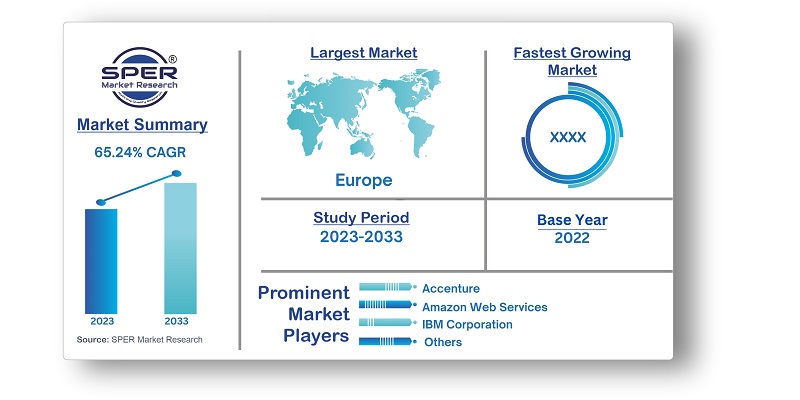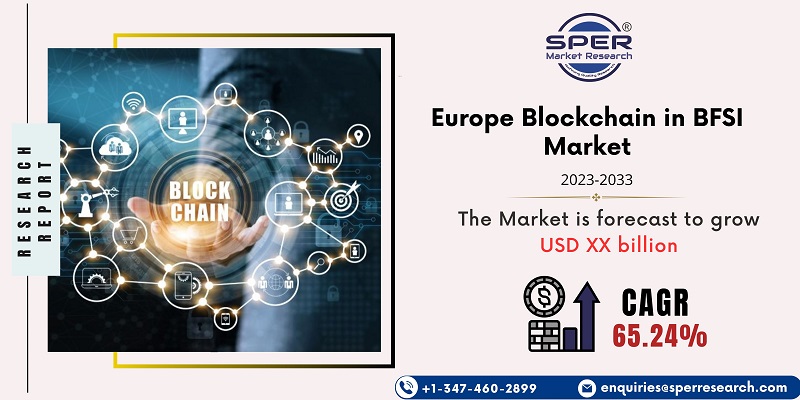
Europe Blockchain in BFSI Market Growth, Size, Trends, Scope, Revenue, Share and Future Outlook
Europe Blockchain in BFSI Market Size- By Type, By Application- Regional Outlook, Competitive Strategies and Segment Forecast to 2033
| Published: Nov-2023 | Report ID: BFSI2352 | Pages: 1 - 153 | Formats*: |
| Category : BFSI | |||
- July 2018: IBM, a prominent player in the European blockchain market for the banking and financial services industry, announced a cooperation with CLS, a blockchain platform. Nine additional budgetary administration companies, including banks like Barclays and Citi, have joined this platform in addition to IBM.
- May 2019: Another big player in the market, Deloitte, tested staff credential verification using data management on the Ethereum blockchain with three Irish banks (Bank of Ireland, Ulster Bank, AIB, and Institution of Banking).


| Report Metric | Details |
| Market size available for years | 2019-2033 |
| Base year considered | 2022 |
| Forecast period | 2023-2033 |
| Segments covered | By Type, By Application |
| Regions covered | France, Germany, Italy, Spain, Switzerland, United Kingdom, Others |
| Companies Covered | Accenture, Amazon Web Services, Hewlett Packard Enterprise Development LP (HPE), IBM Corporation, Intel Corporation, Microsoft Corporation, Oracle Corporation, Others |
- BFSI Companies
- BFSI Market Entrants
- Distributors and suppliers
- finance companies
- Government Bodies & Regulating Authorities
- Industry Associations
- Market Researchers and Analysts
- Potential Investors
- Providers
- Others
| By Type: |
|
| By Application: |
|
- Europe Blockchain in BFSI Market Size (FY’2023-FY’2033)
- Overview of Europe Blockchain in BFSI Market
- Segmentation of Europe Blockchain in BFSI Market By Type (Consortium, Hybrid, Private, Public)
- Segmentation of Europe Blockchain in BFSI Market By Application (Digital Currency, Payments & Settlement, Record Keeping)
- Statistical Snap of Europe Blockchain in BFSI Market
- Expansion Analysis of Europe Blockchain in BFSI Market
- Problems and Obstacles in Europe Blockchain in BFSI Market
- Competitive Landscape in the Europe Blockchain in BFSI Market
- Impact of COVID-19 and Demonetization on Europe Blockchain in BFSI Market
- Details on Current Investment in Europe Blockchain in BFSI Market
- Competitive Analysis of Europe Blockchain in BFSI Market
- Prominent Players in the Europe Blockchain in BFSI Market
- SWOT Analysis of Europe Blockchain in BFSI Market
- Europe Blockchain in BFSI Market Future Outlook and Projections (FY’2023-FY’2033)
- Recommendations from Analyst
1.1. Scope of the report1.2. Market segment analysis
2.1. Research data source2.1.1. Secondary Data2.1.2. Primary Data2.1.3. SPER’s internal database2.1.4. Premium insight from KOL’s2.2. Market size estimation2.2.1. Top-down and Bottom-up approach2.3. Data triangulation
4.1. Driver, Restraint, Opportunity and Challenges analysis4.1.1. Drivers4.1.2. Restraints4.1.3. Opportunities4.1.4. Challenges4.2. COVID-19 Impacts of the Europe Blockchain in BFSI Market
5.1. SWOT Analysis5.1.1. Strengths5.1.2. Weaknesses5.1.3. Opportunities5.1.4. Threats5.2. PESTEL Analysis5.2.1. Political Landscape5.2.2. Economic Landscape5.2.3. Social Landscape5.2.4. Technological Landscape5.2.5. Environmental Landscape5.2.6. Legal Landscape5.3. PORTER’s Five Forces5.3.1. Bargaining power of suppliers5.3.2. Bargaining power of buyers5.3.3. Threat of Substitute5.3.4. Threat of new entrant5.3.5. Competitive rivalry5.4. Heat Map Analysis
6.1. Europe Blockchain in BFSI Market Manufacturing Base Distribution, Sales Area, Product Type6.2. Mergers & Acquisitions, Partnerships, Product Launch, and Collaboration in Europe Blockchain in BFSI Market
7.1. Europe Blockchain in BFSI Market Value Share and Forecast, By Type, 2023-20337.2. Consortium7.3. Hybrid7.4. Private7.5. Public
8.1. Europe Blockchain in BFSI Market Value Share and Forecast, By Application, 2023-20338.2. Digital Currency8.3. Payments & Settlement8.4. Record Keeping
9.1. Europe Blockchain in BFSI Market Size and Market Share
10.1. Europe Blockchain in BFSI Market Size and Market Share By Type (2019-2026)10.2. Europe Blockchain in BFSI Market Size and Market Share By Type (2027-2033)
11.1. Europe Blockchain in BFSI Market Size and Market Share By Application (2019-2026)11.2. Europe Blockchain in BFSI Market Size and Market Share By Application (2027-2033)
12.1. Europe Blockchain in BFSI Market Size and Market Share By Region (2019-2026)12.2. Europe Blockchain in BFSI Market Size and Market Share By Region (2027-2033)12.3. France12.4. Germany12.5. Italy12.6. Spain12.7. Switzerland12.8. United Kingdom12.9. Others
13.1. Accenture13.1.1. Company details13.1.2. Financial outlook13.1.3. Product summary13.1.4. Recent developments13.2. Amazon Web Services13.2.1. Company details13.2.2. Financial outlook13.2.3. Product summary13.2.4. Recent developments13.3. Hewlett Packard Enterprise Development LP (HPE)13.3.1. Company details13.3.2. Financial outlook13.3.3. Product summary13.3.4. Recent developments13.4. IBM Corporation13.4.1. Company details13.4.2. Financial outlook13.4.3. Product summary13.4.4. Recent developments13.5. Intel Corporation13.5.1. Company details13.5.2. Financial outlook13.5.3. Product summary13.5.4. Recent developments13.6. Microsoft Corporation13.6.1. Company details13.6.2. Financial outlook13.6.3. Product summary13.6.4. Recent developments13.7. Oracle Corporation13.7.1. Company details13.7.2. Financial outlook13.7.3. Product summary13.7.4. Recent developments13.8. Others
SPER Market Research’s methodology uses great emphasis on primary research to ensure that the market intelligence insights are up to date, reliable and accurate. Primary interviews are done with players involved in each phase of a supply chain to analyze the market forecasting. The secondary research method is used to help you fully understand how the future markets and the spending patterns look likes.
The report is based on in-depth qualitative and quantitative analysis of the Product Market. The quantitative analysis involves the application of various projection and sampling techniques. The qualitative analysis involves primary interviews, surveys, and vendor briefings. The data gathered as a result of these processes are validated through experts opinion. Our research methodology entails an ideal mixture of primary and secondary initiatives.



Frequently Asked Questions About This Report
PLACE AN ORDER
Year End Discount
Sample Report
Pre-Purchase Inquiry
NEED CUSTOMIZATION?
Request CustomizationCALL OR EMAIL US
100% Secure Payment






Related Reports
Our Global Clients
Our data-driven insights have influenced the strategy of 200+ reputed companies across the globe.






















